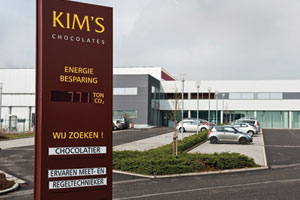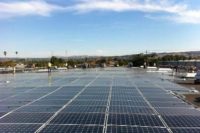Kim’s Chocolates N.V.
Tienen, Belgium
....................................................
If one were to design a totally green confectionery manufacturing facility from scratch, Kim’s Chocolates N.V. in Tienen, Belgium, would provide an excellent blueprint.
Built in 2008, the emphasis on creating an energy efficient and ecologically friendly plant started from day one. As Fonds Maex, ceo of the Belgian chocolate producer points out, “The construction in 2007-2008 of our new factory in Tienen has given us the opportunity to achieve many things, which would not have been possible in our former building.”
Let’s start with the building materials, which are all 100% recoverable. Given that chocolate manufacturing requires precise temperature control, the outer walls were built with well-insulated aerated concrete. In addition, the roof was finished with a material offering high insulation levels.
Moreover, the top layer of the roof cladding has a white finish, which means lower heat absorption through the building in the summer — thereby reducing the need for cooling. Moreover, the air intakes of the ventilation system, which are placed on the roof, take in cooler air. Finally, the diffusion of solar radiation makes a small, yet positive contribution to the yield of the company’s solar panel array (More on that later).
In the production areas, interior spaces featuring additional thermal insulation were created, not only to promote a much better hygiene, but also to impact energy consumption positively. Separate water pipe systems were also installed in the building so the toilets could be flushed with rainwater.
With regards to lighting, the company opted for “energy-saving bulbs.” In most places, fluorescent lamps with electronic ballast have been fitted. Meanwhile, the offices, toilets and changing rooms all feature automatic lighting control — the lights only turn on if there is not enough natural light and if a presence is detected in those spaces.
Because a cooling system consumes a great deal of energy, Kim’s Chocolates opted for an ammonia-based “chiller” to convert electric energy into thermal energy, which today remains the most efficient system.
A central cooling duct runs through the plant connecting to most of the company’s production lines and other equipment, allowing work at higher temperatures and, thus, reducing energy consumption.
Because compressed air uses insidiously huge amounts of energy, the company chose frequency-controlled compressors to reduce the energy consumption. In addition, regular inspections are carried out to detect possible leaks in compressed air lines, valves and connections.
In Belgium, there are strict standards regarding wastewater discharge. Naturally, Kim’s Chocolates focuses on limiting water consumption. For example, all the systems that use water for cooling or heating purposes are closed systems.
Most of the company’s wastewater discharge comes from cleaning mixing drums and production lines, washing moulds and cleaning the floors. As a result, the wastewater contains sugars, proteins, fats and other nutrients.
With the help of the Flemish government, the company set up a pilot project in its older facility to test removing these nutrients from the wastewater before discharging it into the sewage network. Based on the principle of bio-fermentation, the wastewater — after going through a grease trap — is distributed into a container full of coconut fiber. Most of the nutrients are absorbed by the fibers, after which a bacterial culture breaks down the proteins and sugars.
The effluent that comes out from underneath is again spread over a second container to undergo a second purification. Subsequently, the effluent is directed to a sedimentation pond, also filled with coconut fiber. From there, it’s discharged into the sewage system.
Although it took significant testing and technical tweaking to meet the strict wastewater standards, the process now meets requirements. Kim’s Chocolates’ long-term goal is to meet the standards for discharges into surface waters, which are the strictest standards in Belgium.
Finally, a chocolate facility like Kim’s Chocolates uses a tremendous amount of energy. As Maex points out, “A kilowatt that is not used still has the most impact on the environment. Furthermore, our technical department is continuously looking for ways to fine tune our installations even more, to implement energy-friendly components, such as frequency-controlled motors, and to monitor consumption.”
As mentioned earlier, the company has a solar panel array — 2,987 solar panels in total — which provides nearly 20% of Kim’s energy needs.
“Any additional electricity that we buy comes from renewable energies such as solar, wind and water,” he adds. “To this end, we entered into a contract with our current electricity provider for the supply of ‘green power’ with a certificate.”
Longer-term, the company looks to investigate other green energy avenues.
Given these initiatives, it’s not surprising that Kim’s Chocolates was honored in 2008 as the “Most Energy-Conscious SME in Flanders.”










